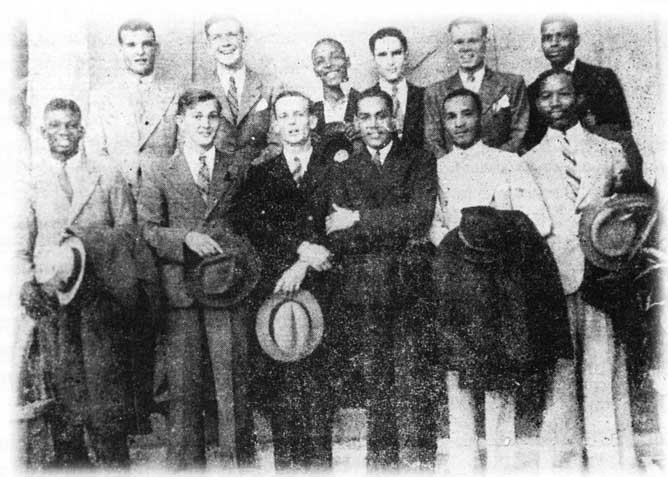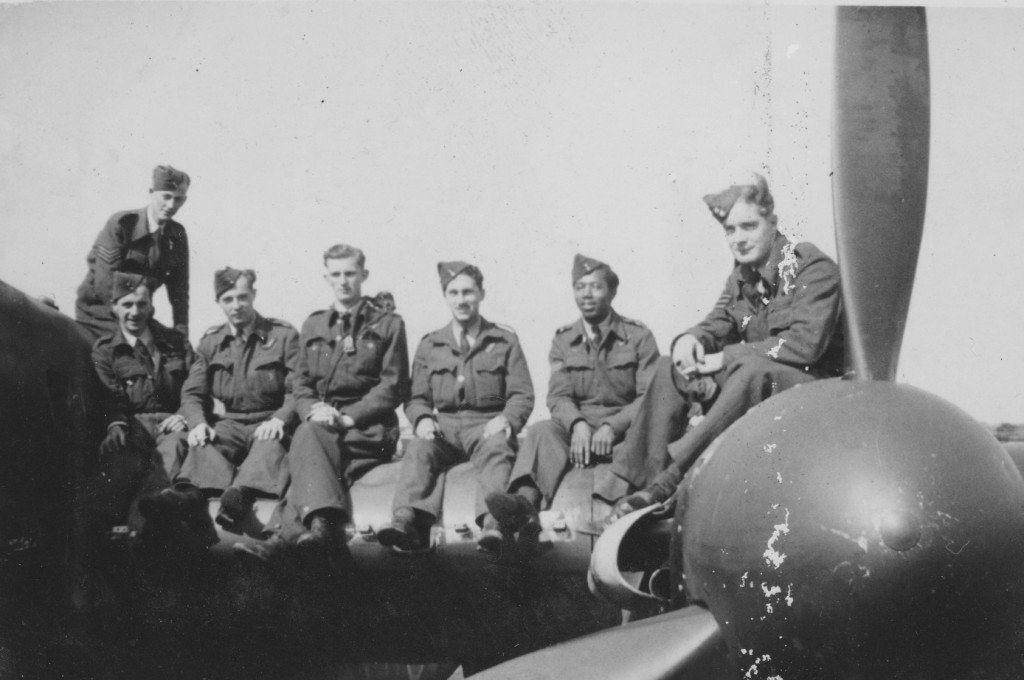LYNCH – Richard Challenor
 |
501 Squadron, May 1942, at RAF Ibsley near Ringwood. Back Row: F/Sgt Shadbolt, Sgt Henderson, F/Sgt Carmody, Sgt Collis. Middle Row: P/O Brannigan, Sgt Kelly, F/Sgt Macdonald, F/sgt Moore, Sgt Leitch, P/O Jackson, P/O De-Merode, P/O Smith, P/O Mawer, Sgt Strang. Front Row: F/O Torbill, F/O Drossart, S/L Sine, S/L Villa, F/L Stanbury, P/O Lynch, P/O Lightborn.
[Photo provided by Eric Moore]
Richard ‘Dickie’ Lynch was born in Barbados, West Indies in 1921 to Cyril
Aubrey Lynch and his wife Louise (nee Webster, of York), and was married
in the UK to Patricia Farrar. He was a Spitfire pilot based at RAF Ibsley,
not far from Bournemouth on the south coast of England, and was killed in
action over the English Channel.
Pilot Officer Richard C Lynch (RAF service number 115146) was posted to
501 Squadron in September 1941. Dickie’s posting to 501 Squadron would
have been his first operational posting, after having completed his
operational training as a fighter pilot at No 57 Operational Training Unit
at Hawarden in North West England, not far from the city of Chester.
It was during the month of September 1941, when Dickie first arrived at
Ibsley airfield, that a famous movie film called “First of the Few” was
being shot at Ibsley. This film starred actors David Niven and Leslie
Howard and told the story of the Supermarine Spitfire and its designer RJ
Mitchell.
The crews of 501 Squadron became film stars as the Air Ministry agreed to
provide aircraft for the flying sequences that were shot at the location.
The Spitfires of 501 Squadron were chosen for this role because they were
still operating the Mark II spitfire which had been flown two years
earlier during the Battle of Britain in 1940. The Mark II Spitfire was
required because it did not have the distinctive cannon of the later
Marks, but still sported an armament of 8 .303″ machine guns.
The starring pilots were drawn from both 501 and 118 squadrons, both based
at Ibsley at the time. These pilots play themselves effectively, as pilots
debriefing after a previous air combat engagement and then waiting at
dispersal for the next “scramble” order, whilst listening to David Niven
telling them the story of RJ Mitchell and the Spitfire.
The Squadron Commander of 501 Squadron, Squadron Leader Chris “Bunny
Currant”, actually had a minor role in the film and played a small cameo
as a friend of David Niven’s character “Crisp”. He is “shot-down” and
killed by a German ME109 during the exciting battle scene at the climax of
the movie.
In later years, when talking to school children about his war years, one
little girl asked him if it was true that he had been “shot down” in the
movie. With his usual sense of humour and a twinkle in his eye, Bunny
replied with a straight face that yes, it was perfectly true that he had
been “shot down”, and in fact of all the instances during the war years
when he had been shot down, that was the only occasion when he had been
“shot down and killed”. Bunny Currant was the 501 Squadron Commander and
later became commander of the whole Ibsley Wing, which comprised three
Squadrons including 501. Sadly, Bunny died in 2008.
Dickie flew with the squadron until he was posted missing on 17th
September 1942. He would therefore have participated in the great air
battle over Dieppe in August 1942, when a chiefly Canadian assault force
attempted a large-scale raid on the French coast near Dieppe. The RAF was
called upon to provide air cover for this amphibious raid, which provoked
a massive response from the German Luftwaffe.
For the Dieppe raid, 501 Squadron was deployed to Tangmere airbase near
Chichester in the South Coast on England. They escorted a formation of
Blenheim light bombers over towards the Dieppe area at about 0750 hours,
but this mission was cancelled and they returned to base; a further
mission was flown at 1024, when they escorted some Hurri-bombers which
were briefed to attack gun emplacements on East Beach at Dieppe.
In mid afternoon, the Germans started to attack the main landing ship
convoy with Dornier 217 and Junkers 88 bombers, escorted by FW190
fighters. 501 Squadron along with other fighter units, were scrambled at
1455 hours to assist the ships at the rear of the flotilla. Reaching the
convoy about 8 miles off Dieppe, the Squadron was immediately involved in
a furious scrap with ten FW190s, several of which were damaged by 501
Squadron pilots.
Dickie was flying Spitfire Mark V (serial number EP871, Squadron Code
letters SD-L) when he was reported missing, following a convoy patrol. It
is interesting to note that Pilot Officer John Scott, flying Spitfire
serial number AB491 (SD-Y), was also lost on the same routine convoy
patrol. It is understood that “Scotty” baled out after being attacked by a
FW190 over Lyme Bay, but his parachute failed to open. It therefore seems
reasonable to conclude that Dickie was also shot down by FW190s.
In fact, the Squadron was plagued by a series of unrelated incidents over
the period 27 August to 17 September 1942, during which time no less than
7 pilots (about 30% of a typical Squadron strength) were killed in action
or in flying accidents. Hence the Squadron was withdrawn from operations
in October 1942 and moved to Ballyherbet in Northern Ireland.
Here the Squadron continued to perform convoy escort duties, but was
essentially on a rest tour. It is sad to think that had he survived the
convoy patrol, his unit may have pulled out of the front line for rest
shortly afterwards, and he may have survived the war as a result.
There is not much detail about Dickie’s success as a fighter pilot. One
day whilst filming the movie “First of the Few”, the Squadron was
scrambled from Ibsley to intercept a Ju88 at 18000 feet South of Portland
Bill. Bunny Currant decided that it was a useful learning experience for
the whole squadron, since some pilots had not even fired their guns in
anger yet. He therefore let everyone have a shot at it. It eventually
crashed onto rocks at Cap de La Hague on the Cherbourg Peninsula, and
Bunny received a scolding from Fighter Command who felt that it was
overdoing it to use over 20,000 rounds of ammunition on it. As Dickie was
a new pilot on the Squadron, it is expected that he would have been one of
the new pilots that Bunny was concerned about;, and if he was flying that
day, he would have been entitled to claim a twelfth of a “Confirmed” kill!
Dickie was also credited with a 1/2 share claim in a “probably destroyed”
Junkers 88 which was shot at on 13th March 1942 near to Casquettes at 1730
hours, whilst flying Spitfire Mark V Serial Number AD538. He shared the
claim with Wing Commander Ian Gleed, a famous Battle of Britain pilot who
was commander of the Ibsley wing at the time. Ian Gleed was later killed
in North Africa in 1943. For a kill to be classed as “Probably Destroyed”
it would be fairly badly damaged, with smoke and/or flame trailing, and
most likely to crash but not actually witnessed to do so.
Dickie’s Spitfire EP120 still exists as an airworthy aircraft to this day,
although not painted in its 501 Squadron markings. It is now operated by
the Fighter Collection at Duxford in UK.
The Commonwealth War Graves Commission
In Memory of
RICHARD CHALLENOR LYNCH
Pilot Officer
115146
501 Sqdn., Royal Air Force Volunteer Reserve
who died on
Thursday, 17th September 1942. Age 21.
Buried at FULFORD CEMETERY, Yorkshire, United Kingdom
Grave Reference/Panel Number: Plot 16. Row W. Grave 18.
Record of Commemoration
In Memory of
Pilot Officer RICHARD CHALLENOR LYNCH
501 Sqdn., Royal Air Force Volunteer Reserve
who died aged 21 on Thursday, 17th September 1942.
Serial: EP871; Mark: Vb; Fac: CBAF; Eng: M46; History : 15MU 10-8-42 501S
‘SD-L’ 1-9-42 Shot down by Fw190 on convoy patrol 17-9-42 FH25.15 P/O R C
Lynch baled out too low and killed.
 |
Aerial photo of Ibsley airfield, January 1944
 [ [ |
[Gravestone Marker Photo provided by James Lynch]
To the ever glorious memory
of my dearly loved husband
Richard Challenor Lynch
Pilot Officer 501 (Spitfire) Sqdn
killed in combat over the English Channel
September 17th 1942
aged 21 years
To save Mankind
Himself he scorned to save.
—
The two framed signature boards in the the pub nook behind the dining room
bar at the St. Leonard’s Hotel, west of Ringwood, near Ibsley, where the
pilots of many nationalities based at the airfield during the war used to
go for “recreation”. This Hotel is on the A31 just west of the western
A338-A31 roundabout (the A31 and A338 split again at the next roundabout
east). The enlarged image shows the signature R C Lynch.
1. Left Signature Board
2. Right Signature Board
3. Signature found of R.C.Lynch
   |
[Source: James C. “Jim” Lynch]















 Promoting the Noble Heritage of Caribbean Air Crew who Served in Freedom's Cause in World War II - The Law Firm of Gabriel J Christian & Associates, LLC.
Promoting the Noble Heritage of Caribbean Air Crew who Served in Freedom's Cause in World War II - The Law Firm of Gabriel J Christian & Associates, LLC.